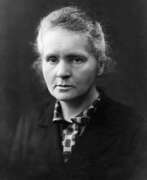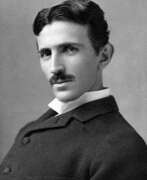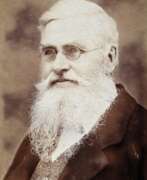Naturalists 19th century
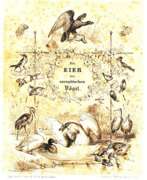

Friedrich Baedeker, full name Friedrich Wilhelm Justus Baedeker or F. W. J. Baedeker, was a German pharmacist, bird egg collector and bird illustrator.
In addition to his work as a pharmacist, Baedeker had a passion for ornithology and was a good artist. His 774 watercolors are known, depicting some 386 European birds. In time, Baedeker became widely known as an ornithologist and zoologist, and his huge collection included about 4,000 eggs of various European and exotic birds.
Baedeker joined the Deutsche Ornithologen-Gesellschaft (German Society of Ornithologists) in 1851, shortly after its founding, and published several books on birds. One of these was Die Eier der europaeischen Voegel nach der Natur gemalt ("The Eggs of European Birds Drawn from Nature").


Charles Baker was a British educator, pioneer in deaf education, naturalist and artist.
He became known and honored in Great Britain for having developed the first school textbooks for deaf-blind children, including those based on drawing.
As a young man he became a teacher at the Edgbaston Institute for the Deaf and Dumb in Edgbaston, near Birmingham, and was faced with a complete lack of textbooks for such children. Baker had a passion for entomology, and began directing the attention of his older pupils to the various objects of natural history around them. As a result, in 1828, he authored a small volume of illustrations entitled British Butterflies: their differences, genera and species, with lithographic illustrations of each genus, comprising 33 species, drawn by the children of the Edgbaston School for the Deaf and Dumb."
Charles Baker worked as a teacher of the deaf and headmaster at Doncaster School for forty-five years. During this time he produced many specialized teaching guides and textbooks under the general title "Circle of Knowledge", which were used in Europe and Russia, as well as in China and Japan.


Henry Walter Bates was a British naturalist, biologist and traveler.
As a young man, Henry worked in a factory and attended the local mechanical institute, where he excelled in Greek, Latin, French, drawing and composition, later learning German and Portuguese. He also practiced classical music and was an avid entomologist.
In 1844, Bates met entomologist Alfred Russel Wallace, who a few years later invited him to go to the tropical jungle on a scientific expedition. In May 1848, they arrived in Para, Brazil, near the mouth of the Amazon River. Wallace returned to England four years later, but Bates remained there for a total of 11 years, exploring the entire Amazon Valley, where he collected some 14,712 species, mostly insects, of which 8,000 were previously unknown.
On his return to England in 1859, Bates began working on his vast collections and preparing a famous paper published in 1862 entitled Contributions to an Insect Fauna of the Amazon Valley. In 1864 Bates was appointed assistant secretary of the Royal Geographical Society (London), a position he held until his death. He wrote The Naturalist on the Amazon River (1863), as well as many works on entomology.
Bates's work in demonstrating the action of natural selection in animal mimicry (imitation of other living organisms or inanimate objects) provided strong support for Charles Darwin's theory of evolution. Much of Bates's insect collections are in the British Museum.


Matthieu Bonafous was a prominent French botanist and agronomist.
Bonafous was an innovator in 19th century agronomy, specializing in technical farming, with a particular interest in corn and its economic importance as a food crop. He also studied mulberry trees and created new species for silkworm breeding, and wrote many scientific articles, including one on rice.
As a teacher, Matthieu Bonafous offered a traveling course based on direct contact with practitioners of scientific farming.


Aimé Bonpland, born Aimé Jacques Alexandre Goujaud, was a French and Argentine natural scientist, traveler, physician, and botanist.
Bonpland became famous for his participation in an expedition to the Americas. Together with the explorer Alexander von Humboldt, he traveled through much of the American territory, from Cuman to the United States, passing through Colombia, Ecuador, Peru, Mexico, and Cuba, in addition to Venezuela. In all these places he did a great deal of botanical work, describing and collecting six thousand species of American plants, many of which were new. The scientist made them known in Europe after his return in 1804, publishing several scientific papers. Four years later, Bonpland was appointed botanist of the Empress's Garden.
After more years, he returned to Buenos Aires and continued numerous botanical, zoological, and medical studies in various regions of South America. Bonpland sent plants to the Museum of Natural History in Paris and maintained correspondence with its naturalists.


Mathurin Jacques Brisson was a French zoologist, ornithologist, naturalist and physicist, a member of the Academy of Sciences.
He is known for his published works in natural history: Le Règne animal ("The Kingdom of Animals", 1756) and Ornithologie ("Ornithology", 1760), in which he described 1,500 species of birds grouped into 115 genera, twenty-six orders, and two classes. Brisson was one of the first to come close to the concept of "type" in zoology, although he does not use the term, but his classification was used for about 100 years. He translated a number of important books on zoology for his time into French.
Brisson's works in physics are related to the measurement of specific gravity of various bodies, the study of gases and refraction of light, mirrors, magnetism, atmospheric electricity, and barometers.
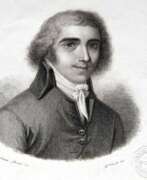

Giovanni Battista Brocchi was an Italian mineralogist, geologist and paleontologist.
Brocchi studied law at the University of Padua, but was seriously interested in natural sciences and mineralogy. In 1802, Brocchi became a teacher of natural history at the Brescia Gymnasium. Appointment in 1808 as inspector of mines in Milan gave him the opportunity to travel extensively in Italy, making extensive notes and collecting numerous samples. The fruits of these labors appeared in various publications, notably his "Treatise mineralogical and chemical on the iron mines of the department of Mella" (1808). He then obtained a position as inspector of mining in the newly created kingdom of Italy.
In 1811 Brocchi wrote a valuable essay entitled "Mineralogical Memoirs on the Fassa Valley in the Tyrol." He made his first extensive exploration of central Italy in 1811-1812, witnessed the eruption of Vesuvius, and was able to compare the condition of its crater before and after the eruption. But his most important work is Fossils of the Sub-Apennines with geological observations on the Apennines and adjacent soil (1814), which contains precise details of the structure of the Apennine ridge and an account of the fossilization of Italian Tertiary strata in comparison with existing species. Brocchi also wrote several significant works on biology.
In the fall of 1822 he sailed from Trieste to Egypt, whence he made excursions up the Nile and into Syria and Palestine. In 1826 he contracted the bubonic plague, of which he died. His last journals and collections are preserved at the Museo Civico in Bassano. In all, Brocchi published five voluminous books and about seventy articles in various journals.


Carl Gustav Carus was a German painter of the first half of the 19th century. He is known as a landscape painter, as well as a scientist, physician (gynecologist, anatomist, pathologist, psychologist) and a major theorist of Romanticism in art.
Carus created idyllic landscapes depicting moonlit nights, mountains, forests, Gothic architecture and ruins. In his work, according to critics, he combined a romantic view of nature with the classical ideal of beauty, understood the beautiful as a triad of God, nature and man. Noteworthy are his small-format, spontaneously created landscape sketches with images of clouds. The master is the author of "Nine Letters on Landscape Painting" - one of the main theoretical works that laid the foundations of the German Romantic school of painting.
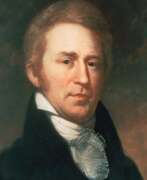

William Clark, an American frontiersman, is best known for co-leading the epic Lewis and Clark Expedition alongside Meriwether Lewis from 1804 to 1806. This journey was a monumental exploration of the American West, extending to the Pacific Northwest, which laid the foundation for westward expansion and significantly contributed to the nation's knowledge of the vast territory.
Before his fame as an explorer, William Clark had a substantial military career, beginning with his service in the militia and the U.S. Army during the Northwest Indian War. His experiences in the military, including participation in the Battle of Fallen Timbers, honed his leadership and survival skills, which were crucial for the success of the Lewis and Clark Expedition.
Following the expedition, William Clark continued to serve in significant roles, including as the governor of Missouri Territory and as a superintendent of Indian Affairs. His later years were dedicated to managing relations with various Native American tribes, navigating the complexities of the expanding American frontier.
For collectors and experts in art, history, and antiques, William Clark's life and contributions offer a fascinating lens through which to explore the early 19th-century American narrative. His maps, journals, and other related artifacts provide a unique perspective on this formative period in U.S. history.
To stay informed about new discoveries, exhibitions, and auction events related to William Clark, consider subscribing for updates. This subscription will provide you with valuable insights into the lasting impact of Clark's legacy on American culture and history.


John Curtis was a British entomologist and illustrator, and a Fellow of the Linnean Society.
As a young man, John Curtis studied engraving and became increasingly interested in entomology. In 1824 he began publishing his major work entitled British Entomology: illustrations and descriptions of the genera of insects inhabiting Great Britain and Ireland, which is still considered the best 19th century encyclopedia on the subject. It was published monthly by subscription from 1824 to 1839, each issue containing four plates with two pages of accompanying text. The finished work consisted of 16 volumes covering 770 species of insects. The French naturalist and zoologist Georges Cuvier (1769-1832) called British entomology "a model of perfection."


Joseph Wilhelm Eduard d'Alton was a German engraver, naturalist and educator.
He had an initial military education and later studied art and natural history while traveling in Italy and France. Eduard d'Alton is widely known for his anatomical and zoological engravings and etchings. In 1818, d'Alton was appointed professor of natural history at the University of Bonn, where he later began to teach art history as well. Among his students was Karl Marx.
D'Alton's son Johann Samuel Eduard d'Alton (1803-1854), professor of anatomy, continued his father's unfinished Osteologie (Bonn, 1827-1838) and published the first volume of the Handbook of Comparative Human Anatomy.
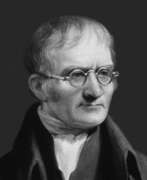

John Dalton was a British scientist, chemist and physicist, naturalist, and pioneer in the development of modern atomic theory.
In the 1800s, he was the first scientist to explain the behavior of atoms in terms of weight measurements. Some of the tenets of Dalton's atomic theory proved to be false, but most of the conclusions remain valid to this day.
Problems with his own eyesight led Dalton to research and describe the visual defect he himself suffered from in 1794 - color blindness, later named color blindness in his honor.


Charles Robert Darwin was an English naturalist, geologist, and biologist, widely known for contributing to the understanding of evolutionary biology. His proposition that all species of life have descended from a common ancestor is now generally accepted and considered a fundamental concept in science. In a joint publication with Alfred Russel Wallace, he introduced his scientific theory that this branching pattern of evolution resulted from a process that he called natural selection, in which the struggle for existence has a similar effect to the artificial selection involved in selective breeding. Darwin has been described as one of the most influential figures in human history, and he was honoured by burial in Westminster Abbey.


Sherman Foote Denton was an American naturalist, inventor, illustrator, and writer.
Denton was one of the best later natural history artists. He served as an artist for the Smithsonian Institution's U.S. Fish Commission and was commissioned by the Smithsonian Institution to create the book Game Fish of New York. And the annual reports of the Fish and Game of New York State for 1895-1909 featured 99 species of freshwater and marine fish, as well as a number of other items, including lobsters, oysters, ring-necked pheasant, and Virginian deer. These have been published in both book and folio form. Denton also developed a method of mounting fish that preserved their lifetime color.
Along with his brothers Shelley Wright and Robert Winsford, Denton founded the Denton Brothers Butterflies Company, which sold butterfly specimens. Sherman invented and patented in 1901 the mounting of scale specimens on a white plaster tablet under glass instead of the traditional mounting.
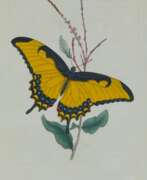

Edward Donovan was a British-Irish amateur zoologist, illustrator and writer.
He was an avid collector and founded the Natural History Museum and Institute in London, which housed his extensive collection of natural history objects. Donovan was the author of a large number of works on natural history, and wrote several volumes on British birds, fish, and insects, botanical surveys, and on the entomology of China and India. All of these publications were supplied with good quality and detailed illustrations.


Dru Drury was a British entomologist and collector.
Dru Drury was an avid collector and his entomological collection totals 11,000 specimens. Drury corresponded extensively with entomologists from all over the world, from India to Jamaica to America, and bought any insects for 60 cents from officers of merchant ships arriving from afar. He even supplied travelers with a pamphlet of collecting instructions. It was through this work that Drury amassed most of his collection. From 1770 to 1787 he published three volumes on entomology, Illustrations of Natural History, with over 240 drawings of exotic insects.
Drury was president of the Society of Entomologists of London from 1780 to 1782, and a member of the Linnaean Society.


Charles-Frederic Dubois was a Belgian naturalist, artist and author of books on birds and butterflies.
Based on the results of his study of birds and scales of Belgium, Academician Dubois wrote Planches colorées des oiseaux de l'Europe ("Colored Plates of Birds of Europe") and Catalog systématique des Lépidoptères de la Belgique ("Systematic Catalog of Scales of Belgium"), which after his death was completed by his son Alphonse Joseph Charles Dubois (1839-1921).


Alphonse Dubois, full name Alphonse Joseph Charles Dubois, was a Belgian naturalist and physician.
Alphonse Dubois had a doctorate in medicine and in 1869 became curator of vertebrate animals at the Royal Museum of Natural History in Brussels. He worked with his father, the academician Charles-Frédéric Dubois (1804-1867), on the publication Les Oiseaux de l'Europe et leurs œufs (The Birds of Europe and their Eggs), completing it after his father's death. The book consisted of two volumes, the second of which consisted of illustrations by Dubois Sr.


William Henry Edwards was an American amateur naturalist, entomologist, and businessman.
Edwards was a pioneer in the West Virginia coal industry, opening some of the earliest mines in the southern part of the state. He was also an accomplished naturalist and widely recognized as an authority on North American butterflies. As a businessman, he was involved in the coal industry, but the study of butterflies remained his passion.
During his lifetime he published some 250 scientific papers on scales, including a three-volume treatise, Butterflies of North America, which is highly regarded for its scholarship and the quality of its illustrations. Edwards paid great attention to the life stages of the insects in question, describing each stage in detail. The illustrations, on the other hand, were drawn by Mary Pirt, a talented Pennsylvania artist, and hand-colored by Lydia Brown.


Michael Faraday was a British physicist and chemist, explorer and experimenter.
Faraday, because of his family's poverty, was unable to receive a formal education, but at the bookbinding shop in London where he worked, he read many books, including encyclopedias and textbooks on chemistry and physics. He persevered in self-education, attending hearings at the City Philosophical Society and later lectures by Sir Humphry Davy at the Royal Institution, who as a result took the able student on as an apprentice. In 1825 he replaced the seriously ill Davy in the management of the laboratory of the Royal Institution.
In 1833 Faraday was appointed to a research chair of chemistry created especially for him, where, among other achievements, the scientist liquefied various gases, including chlorine and carbon dioxide. His study of heating and lighting oils led to the discovery of benzene and other hydrocarbons, and he experimented extensively with various steel alloys and optical glasses. Faraday was an excellent experimentalist who presented his ideas in simple language. He is best known for his contributions to the understanding of electricity and electrochemistry. The concepts behind electromagnetic induction, diamagnetism, and electrolysis were some of his most important discoveries. His electromagnetic research formed the basis of the electromagnetic equations that James Clerk Maxwell developed in the 1850s and 1860s.
Between 1831 and 1855, Faraday read a series of 30 papers before the Royal Society, which were published in his three-volume Experimental Investigations in Electricity. His bibliography numbers some 500 printed articles. By 1844 he had been elected a member of some 70 scientific societies, including the St. Petersburg Academy of Sciences.


Pelayo Hipólito Fernández was a Spanish traveler and naturalist.
Fernández did extensive collecting work on the islands of Mindanao, Luzon, the Mariana Islands, and others. He founded a private zoological museum in Manila, which was incorporated into the National Museum of Natural Sciences.
In 1887, the Spanish Crown organized an exhibition to present the biodiversity of the Philippines to the Spanish public. For this exhibition, Fernández provided some 2,300 specimens of animals found in the islands, including 106 shells, among which were several type specimens. He also included ethnographic items in the exhibit, including the skulls of two outlaws.


Sir John Forrest was an Australian naturalist, traveler and politician.
He worked as a surveyor and led several exploratory pioneering expeditions to western Australia. On his second voyage in 1870-1871, Forrest made an instrumental survey of the entire southwest coast of Australia from Perth to Adelaide. He later served as Australia's Minister for Defense, and as the first Premier of Western Australia (1890-1901), Forrest sponsored the construction of public works and negotiated the state's entry into the Commonwealth of Australia in 1901.


Christian Friedrich Freyer was a German entomologist.
According to contemporaries, Freyer was a venturesome and tireless collector of scales. He studied and first described 245 species of butterflies, including 193 species of nocturnal moths and 52 species of day butterflies. Freyer's importance as a field entomologist becomes evident from his work Die Falter um Augsburg ("Butterflies in the vicinity of Augsburg"). In it he lists 1,091 species. Freyer also created an international network between renowned European entomologists and involved them in his work.


Adrian Hardy Haworth was a British scientist of entomology, botany and carcinology, and a Fellow of the Linnean Society.
Haworth made significant contributions to botany and entomology, describing many species of plants and insects. He summarized and published the results of his entomological collections in the extensive Lepidoptera Britannica (1803-1828), which was the first major monograph on the scales of Britain and one of the most authoritative works of the 19th century. Haworth was also a carcinologist and specialized in shrimps.


William Chapman Hewitson was a British naturalist, entomologist and artist, a member of the Linnean Society.
After gaining financial independence, Hewitson devoted himself entirely to natural history, particularly the study of scales and birds. His rich collection of exotic butterflies contained over 4,000 species and was considered one of the finest. Hewitson published numerous works on entomology and ornithology and was an accomplished scientific illustrator. His principal work was Illustrations of new species of exotic butterflies, a richly illustrated encyclopedia to which Hewitson devoted the last thirty years of his life, expending enormous personal resources, personally drawing and coloring the figures. At his death he left his entire butterfly collection to the British Museum.


Henry Noel Humphreys was a British artist, illustrator, naturalist, entomologist and numismatist.
He was educated at King Edward's School and studied medieval manuscripts in Italy, and became a distinguished scholar in many fields of science. In addition to publications on entomology, Humphreys wrote works on ancient Greek and Roman coins, archaeology, and the art of writing and printing.
Humphreys was a successful book illustrator, and is also known for publishing sumptuous books whose design is reminiscent of medieval carved and jeweled bindings.
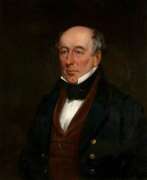

William Jardine was a Scottish naturalist, ornithologist, ichthyologist, artist and publisher of works on zoology.
Jardine studied medicine at the University of Edinburgh and was an excellent sportsman. Although his main passion was ornithology, he also studied ichthyology, botany and geology. Sir William Jardine was a prominent Scottish Victorian naturalist, author and publisher of 40 volumes of the popular Naturalist's Library (1833-43). Of these, 14 volumes were devoted to ornithology, 13 volumes to mammals, 7 volumes to entomology, and 6 volumes to ichthyology.
A series in four volumes, Illustrations on Ornithology, co-written with Prideaux John Selby, was published between 1825 and 1843. His book on burrows and fossil tracks, The Ichnology of Annandale, includes fossils from his ancestral estate. Jardine was a leading expert on salmon and trout in the British Isles. His outstanding knowledge of the species was profound that in 1860 he was appointed a member of the Royal Commission on the Salmon Fisheries of England and Wales. His research culminated in the best and most comprehensive monograph on these fish, "British Salmonids," with the remarkable illustrations by Jardine himself. William Jardine's private natural history museum and library are considered the finest in Britain.


Theophilus Johnson was a British artist, amateur naturalist and publisher.
He trained as a clerical worker and then started his own printing business. Johnson had a passion for the natural sciences and spent much time in the gardens of the Zoological Society of London. His drawings and books cover a wide range of topics, from molluscs to mammals, but his main interest was entomology.
Theophilus Johnson's publications on entomology depict the various species of moths found in the British Isles on beautifully colored watercolor sheets, and include illustrations of their larvae as well as the plants they feed on. During his lifetime he illustrated more than 46 volumes with original watercolors.


François Levaillant was a French ornithologist, traveler and writer.
Levaillant was born in Dutch Guiana, where his father was French consul. He returned with his family to France, where he eventually became a dealer in natural history specimens. At the age of 27, trained as an ornithologist, he traveled to southern Africa with the Dutch East India Company to collect specimens for his collection. Levaillant was one of the first naturalist explorers to venture into uncharted and dangerous Africa to see and study birds in their natural habitat.
Returning to France in 1785 after several years of traveling, he began writing ornithological works based on his diaries. His Histoire naturelle des perroquets (Natural History of Parrots) was published between 1801 and 1805, and his six-volume History of the Nature of Africa was published between 1799 and 1808. Levaillant also wrote the popular book Le Vaillant's Voyage to the Interior of Africa and others. He was one of the first Europeans to make ethnographic observations, empathizing with African peoples and treating them as equals.


Meriwether Lewis was an American explorer renowned for leading the Lewis and Clark Expedition with William Clark from 1804 to 1806. This historic journey, commissioned by President Thomas Jefferson following the Louisiana Purchase, aimed to map the newly acquired territory, establish trade with and assert sovereignty over the native tribes, and find a water route to the Pacific Ocean. The expedition significantly contributed to the American understanding of the vast western territories and its diverse natural resources, flora, fauna, and indigenous cultures.
After the expedition, Lewis was appointed as the governor of the Louisiana Territory, where his administration was met with mixed reviews. He faced numerous challenges, including political disputes and financial troubles. Lewis's life came to a tragic end in 1809 under mysterious circumstances at Grinder's Inn, Tennessee, where he died from gunshot wounds in what is widely believed to be a case of suicide, though some debate around the circumstances persists.
For collectors and enthusiasts in art and antiques, the story of Meriwether Lewis provides a fascinating insight into early American exploration and the historical context that influenced American art and culture during the early 19th century. His legacy, immortalized through various portraits and memorials, continues to be a subject of interest and admiration.
To stay updated on information and events related to Meriwether Lewis and related historical figures, consider subscribing for updates. This subscription will keep you informed about new discoveries, exhibitions, and auction events, enriching your understanding of America's early exploration history.


Matthew Martin was a British merchant, naturalist and philanthropist.
He was a member of the Bath Philosophical Society, and in 1794 was elected a Fellow of the Royal Society. Martin was the initiator of various ideas to improve the welfare of the poor. In addition, he was fond of entomology. His publication "Observations on marine worms, insects, etc., with notes and quotations from various authors" is well known.


Frederic Moore was a British illustrator, naturalist and entomologist.
Moore worked for many years as assistant curator for the East India Company at the London Museum and discovered many species of butterflies. He also published six volumes on the butterflies of South Asia (Lepidoptera Indica) and a catalog of birds in the East India Company's collection.
Frederic Moore was a member of the Linnean Society of London and the Entomological Society of London.


Seth Lister Mosley was a British artist, naturalist and ornithologist.
Although Mosley had no specialized training, he came from a naturalist's family and from a young age was involved in the study of natural history. He visited almost every museum in Britain and became one of the foremost British naturalists in the late nineteenth century.
Mosley was widely known as a taxidermist, illustrator, naturalist, magazine editor, and newspaper columnist. He managed several private museums in Huddersfield before being appointed Keeper of Collections at Huddersfield Technical College, and in 1922 he became the first curator of the Tolson Memorial Museum.


Peter Simon Pállas was a German and Russian scientist-encyclopedist, naturalist and traveler, who gave almost all his life to the service of Russia.
The breadth of his scientific interests made him a true encyclopedist, but he was particularly interested in natural sciences. By the age of 25, Pallas had already acquired European fame as a major scientist-naturalist. At the same time he received an invitation from the St. Petersburg Academy of Sciences, where he was offered a professorship. In 1767, Pallas arrived in St. Petersburg with his wife and soon led several important expeditions to Siberia and southern Russia. In his numerous ethnographic descriptions, the scientist was the first to report in detail on the Kalmyks, Tatars, Mordvins, Chuvashs, Nagaians, Tungus (Evenks), Votyaks (Udmurts), and Cheremis (Mari). In addition, he brought with him large natural-scientific collections. Later he traveled with scientific expeditions to Kamchatka, the Kuril Islands, Crimea and other previously unexplored lands.
In 1785 Catherine II attracted Pallas to the collection and comparative analysis of the languages of the peoples inhabiting America, Asia, Europe and Russia, and he compiled and published a comparative dictionary in two parts (1787-1789), in which more than 200 languages and dialects of the peoples of Asia and Europe were presented. In the last years of his life, among other things, Pallas was engaged in the preparation of a fundamental three-volume work on the fauna of Russia, Zoographia rosso-asiatica ("Russian-Asiatic Zoology"), in which more than 900 species of vertebrates, including 151 species of mammals, of which about 50 new species were introduced. This work was so extensive, and the descriptions of the animals were so thorough and detailed, that until the early 20th century the book remained the main source of knowledge about the fauna of Russia. In 1810. Peter Pallas went to Berlin to prepare illustrations for this work, but a year later the famous scientist died and was buried in Berlin.
A volcano in the Kuril Islands, a reef off New Guinea, and many animals and plants are named after Pallas.


Johann Baptist Emanuel Pohl was an Austrian and Czech scientist, botanist, naturalist, and traveler.
Pohl studied in Prague, earned a doctorate in medicine and practiced science, becoming one of the most prominent botanists in Bohemia. Consequently, he was invited on an expedition to Brazil. Johann Pohl arrived in Brazil in 1817 with the Italian botanist Giuseppe Raddi as part of a large scientific expedition sent by Francis I of Austria, and spent four years traveling through the states of Minas Gerais, Goias, Bahia, and Rio de Janeiro, including some 30 rivers in the country. He collected thousands of plant specimens, as well as studying minerals and zoology, exploring gold and diamond mines, caves, and villages of local people.
After his return to Europe, Pohl served as curator of the Vienna Museum of Natural History and the Museum of Brazil in Vienna until his death. His extensive collections, including some 4,000 plant specimens, were housed here along with the expedition's other scientific collections.


Lawrence Rawstorne was a British naturalist writer.
He is best known for his treatise Gamonia: or the Art of Preserving Game, which is devoted exclusively to the subject of pheasant breeding, concealed shooting, and the management of woodlands for the specific purpose of preserving game. The book contains 15 hand-colored aquatint plates by and drawing by J. T. Rawlins and was published in London in 1837.
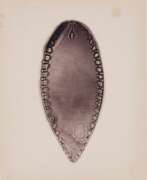

John Thomas Redmayne was a British surgeon, physician and amateur naturalist.
Redmayne trained as a physician and surgeon in Glasgow, then received his diploma at Guy's Hospital in London and was licensed by the Royal College of Physicians in Edinburgh.
In addition to being a physician, J. Redmayne was an amateur naturalist, he became interested in microscopy and specialized in diatom algae. He is considered one of the most successful microphotographers of the time, and his founding of the Bolton Microscopical Society allowed him to concentrate on the study of diatoms. His microscopic diatom plates were highly respected, particularly for the relative purity of the species. He also mounted histological preparations. Redmayne gave copies of his book to the Quekett Microscopical Club (which he joined in 1876) and the Royal Microscopical Society.


Robert Henry Fernando Rippon was a British zoologist, entomologist and illustrator.
Rippon was a musician, but later became passionate about natural history. In the 1860s he made a collecting trip to Panama, New Grenada and South America, and around the same time his talent as a natural history artist developed.
In 1890, Rippon began work on a multi-volume work on the butterfly-birdwings Icones Ornithopterum. He wrote the text himself, drew, lithographed, and hand-colored the plates. The work, eventually published in 25 parts, became his "principal and almost all-purpose occupation" for nearly 20 years.
After Rippon's death, his vast collection was donated to the Natural History Museum. The insects alone numbered 105,760, including more than 21,000 butterflies and 17,000 moths.


Willem Roelofs was a Dutch painter, water-colourist, etcher, lithographer and draughtsman. Roelofs was one of the forerunners of the Dutch Revival art, after the Romantic Classicism of the beginning of the 19th century, which led to the formation of The Hague school. His landscapes, especially the early ones with their dominating cloudy skies, demure bodies of water and populated with cattle, are typical for the School of Barbizon.


Ivan Mikhailovich Sechenov (Russian: Иван Михайлович Сеченов) was a Russian natural scientist, psychologist and physiologist, teacher and educator.
Ivan Mikhailovich was born into an impoverished noble family in the village of Teply Stan, Kurmysh uyezd, Simbirsk province (now the village of Sechenovo, Nizhny Novgorod region), graduated from the Main Military Engineering School, then from the Medical Faculty of Moscow University. For three and a half years Sechenov studied in Germany, engaged not only in biological disciplines, but also in physics and analytical chemistry. Abroad he became friends with S. P. Botkin, D. I. Mendeleev, A. P. Borodin, and the artist A. Ivanov.
In 1860 in St. Petersburg at the Imperial Academy of Medicine and Surgery Sechenov defended his dissertation on "Materials for the Physiology of Alcoholic Intoxication" and received the degree of Doctor of Medicine. Soon he received the post of extraordinary professor at this academy and organized one of the first physiological laboratories in Russia in his department. His record includes work in the laboratory of D. I. Mendeleev, head of the Department of Physiology at Odessa Novorossiysk University, teaching at St. Petersburg University, and professor in the Department of Physiology at Moscow University. Sechenov gave much effort to the development of women's education. He participated in the organization and work of the Higher Women's Courses in the capital, taught at women's courses at the Society of Educators and Teachers in Moscow.
Ivan Sechenov is the founder of the doctrine of mental regulation of behavior, the creator of the first physiological scientific school in Russia. For the first time in history he substantiated the reflex nature of conscious and unconscious activity. He showed that the basis of mental phenomena is physiological processes, substantiated the importance of metabolic processes in the realization of the body's reactions to stimuli. He laid the foundations of physiology of labor, age, comparative and evolutionary physiology. He studied the respiratory function of blood.
Sechenov's main works: "Reflexes of the brain" (1863), "Physiology of the nervous system" (1866), "Elements of thought" (1878), "Sketch of human working movements" (1901), etc. In addition, Sechenov edited "The physiology of the nervous system" (1866). In addition, Sechenov edited translations of books by foreign scientists. Thus, in 1871-1872 under his editorship in Russia was published a translation of Charles Darwin's work "The Origin of Man and Sexual Selection". Among his students were Ilya Mechnikov, Ivan Pavlov, Kliment Timiryazev, Nikolai Vvedensky, and Ivan Tarkhanov, who became famous scientists.


Charles Hamilton Smith was a British illustrator, naturalist, writer, and military spy.
In connection with his military service, Smith traveled extensively throughout the United States, Canada, and India. He was also a talented self-taught artist and illustrated historical works on the military uniforms of the British Empire army, medieval life, drew costumes of native and ancient inhabitants of the British Isles, costumes for the theater stage, and sketched various animals. In 1848 Smith published The Natural History of the Human Species.


Henry David Thoreau is an American writer and poet, philosopher and publicist. He was a prominent representative of American transcendentalism, a friend and associate of Ralph Waldo Emerson.
Henry studied at Harvard University, where he met Ralph Waldo Emerson, the future founder of American Transcendentalism. Thoreau saw Emerson as a guide, a father and a friend. Under his guidance, Henry began to publish his poems and essays with increasing confidence.
In the early spring of 1845, the 27-year-old Thoreau began a new life: he chipped a cabin for himself on the shore of Walden Pond, ate very moderately and meditated. He also read and wrote "A Week on the Concord and Merrimack Rivers," then published in 1849. What eventually emerged was a series of 18 essays called "Walden," describing Thoreau's experimentation with the basics of life. Thoreau's clear and elegant style of presentation brought this work to the level of a literary classic.
Thoreau lived according to the doctrines of transcendentalism recorded in his masterpiece Walden (1854) for two years, and then left the cabin. But life around him had already changed, and little by little his moods began to change as well. Thoreau began to move away from transcendentalism, became more involved in public life, and became a committed abolitionist.
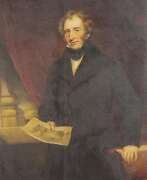

Isaac Weld was an Irish explorer, writer, and artist.
After completing his studies, Isaac Weld traveled to the new lands of America in 1795, meeting Thomas Jefferson and George Washington. The purpose of his journey was to learn of opportunities for Irish resettlement. Returning in 1797, Weld soon published his book, A Journey through the States of North America and the Provinces of Upper and Lower Canada. In general, Weld did not like the United States; he particularly noted the practice of slavery and the treatment of Native peoples by the rude new Americans. But he liked Canada and Quebec: he praised the views from the Citadel and reported that because of the low cost of land, a middle-income person could easily settle in the country for himself and his family.
This book by Weld was quite popular: it went through several editions from its first publication in 1799 to 1807. By 1820, it had also been translated into French, German, Italian, and Dutch.
In 1800 Weld was elected a member of the Royal Society of Dublin. In 1811 and 1812 he served on the library committee, and on December 4, 1828, he was elected honorary secretary. His first act in this capacity was to establish an annual exhibition of specimens of the manufactures and products of Ireland. Isaac Weld published several other books on Ireland and Great Britain, illustrated with his own drawings. Of these, his Statistical Survey of the County of Roscommon, over seven hundred pages long, published by the Royal Dublin Society in 1832, stands out.


Alexander Wilson was a Scottish-born American naturalist, ornithologist, illustrator, and poet.
Wilson emigrated from Scotland to America in 1794, spent several years teaching in Philadelphia and New Jersey, and then became interested in studying native birds. He traveled extensively in the American wilderness and captured and studied over 300 different birds, including several previously unknown. He made his own drawings and detailed descriptions, supported by reading scientific literature.
The results of his research were published under the title American Ornithology in eight volumes beginning in 1808. The ninth volume was published after his death in August 1813. One of the first subscribers was President Thomas Jefferson. Alexander Wilson was a member of the Society of Artists of the United States and the American Philosophical Society. The Wilson Ornithological Society is named in his honor, and a monument is erected in Abbey Close, Paisley. Several species of birds are named in his honor.


Josef Wolf was a German artist and natural history illustrator.
Josef Wolf was already a respected natural history artist in Germany when he moved to London in 1848 and was engaged by the famous English ornithologist John Gould (1804-1881) to illustrate his monographs. Wolf fairly quickly became the most famous animalist painter of the 19th century. In addition to illustrating for Gould, Wolf was responsible for the publication of Zoological Sketches, commissioned by the Zoological Society of London. Wolf was widely recognized during his lifetime; he created the genre of wildlife art.
Wolf's animalistic art consisted of his ability to capture a moment of movement combined with a deep physiological knowledge of animals.


Joseph Wolf was a German artist and natural history illustrator.
Joseph Wolf was already a respected natural history artist in Germany when he moved to London in 1848 and was engaged by the famous English ornithologist John Gould (1804-1881) to illustrate his monographs. Wolf fairly quickly became the most famous animalist painter of the 19th century. In addition to illustrating for Gould, Wolf was responsible for the publication of Zoological Sketches, commissioned by the Zoological Society of London. Wolf was widely recognized during his lifetime; he created the genre of wildlife art.
Wolf's animalistic art consisted of his ability to capture a moment of movement combined with a deep physiological knowledge of animals.






